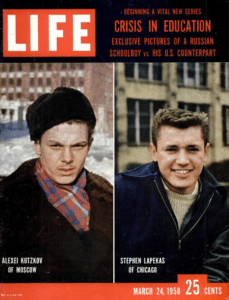April 12 marks the anniversary of the first human spaceflight, achieved by Soviet cosmonaut Yuri Gagarin. On the occasion now called the International Day of Human Spaceflight, we look back on the extraordinary achievement, the U.S.-Soviet space race, and the explosive growth of science and technology education that went with it.
Editor’s note: Random-Access Memories is a new periodic series highlighting the ways in which major historical events have influenced ed tech. Got an idea for a future edition of R-AM? Drop us a line.
“Poyekhali!” he cried as the engines unleashed. “Let’s go!”
On April 12, 1961, the R-7 rocket let loose its nearly two million-pound yield at 9:07 a.m. Moscow time, sending a crackling roar across the dry steppe of Baikonur in Kazakhstan and propelling the Vostok 1 spacecraft beyond Earth’s atmosphere, far beyond the parched brown desert of the planet below. In the process, its captain, Yuri Gagarin, became the first human to leave our planet. His famous exclamation, colloquial and impromptu, has since been adopted around the world as a symbol of optimistic adventure.
Jules Bergman, who extensively covered the space race for ABC News, announced Gagarin’s success to the American public in a scratchy, black-and-white TV report.
“He has now traveled faster, higher, and farther than any man in the history of this planet,” Bergman intoned in a characteristic deadpan. “And no other man can yet claim the same occupation or distinction.”
Racing to the Future
By the time Gagarin was slipping the surly bonds of gravity, the world’s two remaining superpowers had already been running the so-called space race for several years. The Soviets were the first to launch a satellite, Sputnik, and the first to launch a living being, a dog named Laika, into space in 1957. Now they sent a human into the cosmos.
Gagarin’s flight was a pivotal moment in the ongoing competition between the U.S. and USSR. The nations’ ambitions were as much based on scientific curiosity as they were national security, and both countries initiated or expanded massive investments during this period, including the development of technologies that impact our lives daily. If not for the erstwhile competition between two 20th-century superpowers, you may not have that computer in your pocket; the earliest precursors to the modern microchip were developed by Texas Instruments with funding from NASA’s Apollo program.
The competition also spurred American investments in education, particularly in science and engineering, which federal officials believed lagged sorely behind the Soviet model. Funding mechanisms for science and education, like the National Science Foundation, were invented or strengthened during this time, generating ways of thinking about education that continue to this day.
Setting the Foundation for the Space Race
It all started with Sputnik. The first orbiting satellite, it is unerringly described as a beeping, beach ball-sized harbinger of history. The entry of Sputnik, Russian for “companion,” into space marked the explosive beginning of a new phase of the Cold War. For many, that started in the scattered classrooms and schoolhouses across the U.S., schools which previously had seen little direction from above.
In 2007, for the 50th anniversary of Sputnik 1, a panel of education experts gathered at Harvard to discuss the lasting changes to education engendered by the space race. “The post-Sputnik reforms were put in the hands of scientists,” the Harvard Gazette wrote, summarizing the conference. “Several of the changes, such as including hands-on laboratory experience, remain in use today.”
Many essential technologies of modern life, including the Internet, owe their early development to the accelerated pace of applied research triggered by Sputnik.
Rebecca Miller, then a Ph.D. student attending the conference, noted the permanence of the changes to education: “Decades after Sputnik burned in the atmosphere, we’re still talking about science education as a means of security,” Miller said.
“The Russian satellite essentially forced the United States to place a new national priority on research science,” writes Paul Dickon, author of Sputnik — The Shock of the Century. This led, he says, “to the development of microelectronics — the technology used in today’s laptop, personal, and handheld computers. Many essential technologies of modern life, including the Internet, owe their early development to the accelerated pace of applied research triggered by Sputnik.”
Even NASA agrees. “Two generations after the event,” NASA chief historian Roger D. Launius wrote in 1997, “words do not easily convey the American reaction to the Soviet satellite.”
An Emphasis on Education

After Sputnik, the Cold War competition was extending into almost every aspect of American life, including the classroom. In a five-part series, for example, LIFE magazine examined what it considered the failings of the U.S. educational system in comparison to the Soviets.
“The schools are in terrible shape,” they wrote. “What has long been an ignored national problem, Sputnik has made a recognized crisis.”
“It was just a time of incredible intensity and attention to science,” Dr. Shirley Malcolm, an ecologist and student in the late ‘50s, told the New York Times in 2007. With the Soviets claiming the first manned spaceflight, the drive to create a generation of scientists and engineers intensified even further.
Among other programs, the Nation Science Foundation (NSF) saw dramatic changes to its mission during the era. In the two decades after Sputnik soared into orbit, the NSF contributed $500 million for teacher and classroom development. Steven Rissing, now a biology professor at the Ohio State University, was still a student during the space race.
“My friends and I didn’t realize it, but our schools and especially our curricula had changed,” he wrote in the Columbus Dispatch 50 years later. “Our high school biology and physics books were products of new national efforts to reform and expand science education.”
Indeed, while Congress may have been hesitant to expand the federal role in research and education before, the investments seemed inevitable, even vital, after the Soviets made their move toward the stars.
“By connecting the quality of scientific training to the survival of the nation, NSF was able to increase its fellowships budget by more than 100% immediately after Sputnik,” according to research from Clemson University. From 1958 to 1959, the federal budget for NSF fellowships nearly tripled, and the number of fellowship awards more than doubled.
“As undergraduates, our universities supported us with funds from the National Science Foundation to participate in research programs while taking classes and during the summers,” Rissing recalled. “Fellowships from the foundation and the National Institutes of Health supported us during our graduate training and into post-doctoral research. Those same agencies funded our research as we joined college and university faculties across the country.”
Training a Generation
In 1958, in response to the Soviets’ increasing investments in space-related education, Congress passed the National Defense Education Act. The act would not only shift the national narrative around defense education and job training, but mandate new technologies in classrooms. Notably, the law’s Title XII called for research and experimentation in audio and visual technologies in those classrooms. It called specifically for the development of new methods:
- For utilizing and adapting motion pictures, video tapes and other audio-visual aids, film strips, slides and other visual aids, recordings (including magnetic tapes) and other auditory aids, and radio or television program scripts for such purposes;
- For training teachers to utilize such media with maximum effectiveness; and
- For presenting academic subject matter through such media.
Furthermore, the act infused more than a billion dollars into science education, and ushered the arrival of early ed tech, like overhead projectors and lab kits, into more U.S. classrooms, according to NPR. Even NASA’s Jet Propulsion Laboratory credits many of the items we rely on today, everything from dust busters and baby formula to camera phones, laptops, and the computer mouse, to the frenzied scientific focus of the 1960s.
Liftoff
Gagarin’s 108-minute flight reignited the national rivalry, and the Americans were eager to respond. The U.S. had initiated its space program, NASA, in 1958 in part as a response to the Soviet launch of Sputnik, along with the National Defense Education Act. The small silver orb, visible to the human eye on a clear day, put space policy — and the educational needs that went with it — on center stage. So did its successor, the pug-nosed pilot from Klushino, Russia.
The Soviets’ mounting success continued to compel swift changes in American policy. Recalling the event of Gagarin’s flight, Charles Duke, who later commanded the first Moon landing from Houston and touched down himself in 1972, said that despite the ongoing tensions, Gagarin’s success was a catalyst for the Americans.
“We were more focused on the building of the Berlin Wall that year, rather than the space race,” Duke said, according to the BBC. “When he flew, my first impression was, ‘Well, they beat us again.'”
Immediately, the U.S. began devise ways to catch up. “Despite the triumph of Russia’s Major Yuri Gagarin,” the editors of LIFE wrote on April 21, 1961, “the race for space is not over.”
Just a week after Gagarin’s history-making trip, President John F. Kennedy tasked Vice President Lyndon Johnson with identifying a “space program which promises dramatic results.” A month later, the president addressed a joint session of Congress, contending that “the dramatic achievements in space which occurred in recent weeks should have made clear to us all, as did the Sputnik in 1957, the impact of this adventure on the minds of men everywhere,” and announced his hope that America would “commit itself to achieving the goal, before this decade is out, of landing a man on the moon and returning him safely to the Earth.”
Only about a month after Gagarin’s launch, Alan Shepard become the first American astronaut in space, and the American advancements continued apace.
Giant Leaps
Boris Chertok, a Russian engineer responsible for the control systems of the Soviet space program, pointedly connected Gagarin to America’s eventual landing on the Moon in 1969. The Americans had done it, sent human not only into space, but to the Moon and back — and all before the decade was out.
Old Glory’s arrival on the Moon signaled a much-desired American victory in the race, but also a change in how the nation thought of science and technology education and the use of technology in the learning of any subject.
He may not have known it when he let loose his hearty “Let’s go!” but Gagarin, the first person in space, had a hand in the modernization of American education, a legacy we recall today.
Space Race Resources
Looking to connect the space race, its history, and its technological advancements with your class? Check out the resources below, including videos, lesson guides, and useful primary-source documents.
- Space Race Teaching Activities from the National Archives
- Space Race primary sources and teaching guide from the Digital Public Library of America
- Space Race: Project Mercury on DOCSTeach, also from the National Archives
- Race to the Moon! elementary-level lesson guide from the John F. Kennedy Presidential Library and Museum
- The Launch of Sputnik video resources from C-SPAN



7 comments
Sputnik in 1957 spurred a big push for US education towards science and technology. Title X11 of the National Defense Education act included teacher training re: using media and also topics for students to use media in the classroom, visual and auditory. This included a billion dollar budget for educational technology, causing a big change in early education in the United States
I might be remembering incorrectly, but I think it was Title VII, not Title XII, that provided funding for research into technology usage in the classroom.
The article stated title X11………unless there was a typo.
very credibe information! thanks
Thanks for sharing this meaningful information
very informative
Thanks for sharing, it was good information.